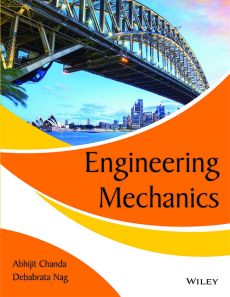Engineering Mechanics
ISBN: 9788126570935
520 pages
Publication Year: 2018
eBook also available for institutional users
For more information write to us at: acadmktg@wiley.com

Description
Engineering Mechanics provides a comprehensive coverage for the Mechanical Engineering
students and Practicing Engineers. With the purpose of providing a smooth transition from high
school mathematics to Engineering Mechanics, a separate dedicated chapter on Vector Algebra
has been introduced at the beginning of this book. The subject matter has been presented with
essential and coherent theoretical background. It also highlights the applications of the theory
learnt through a wide number of worked-out Solved Examples arranged in increasingly difficult
level.
Preface
Statics
Chapter 1 a Quick Glimpse to Vector algebra
1.1 Introduction
1.2 Unit Vector
1.3 Direction Cosines
1.4 Vector as a Line Segment
1.5 Position Vector
1.6 Vector Addition and Subtraction
1.7 Product of Two Vectors
1.8 Vector Equation
1.8.1 Linearly Independent Vectors
1.9 A Look to Different Coordinate Systems
Chapter 2 introduction to Mechanics
2.1 Mechanics – Basic Definitions
2.2 Idealisations and Basic Assumptions
2.3 Dimensions, Law of Dimensional Homogeneity and Units
Chapter 3 Vector Mechanics
3.1 Introduction
3.2 An Introduction to Vector Algebra
3.3 Miscellaneous Vectors
3.4 Vector Resolution and Cartesian Vector
3.5 Position Vector
3.6 Product of Vectors
3.7 Couple-Moment
Chapter 4 Equivalent Force and Moment
4.1 Introduction
4.2 Basic Concept
4.3 Varigon’s Theorem of Moment
Chapter 5 Equilibrium
5.1 Introduction
5.2 Analysis Methodology
5.3 Free Body Diagrams
5.4 Two-Force Member
5.5 Three-Force Member
5.6 Frames and Machines
Chapter 6 Truss
6.1 Introduction
6.2 Types of Truss
6.3 Analysis of Truss
Chapter 7 Friction
7.1 Introduction
7.2 Governing Equation of Friction
7.3 Steps of Analysis
7.4 Friction in Simple Machines
Chapter 8 Central Points and Properties of Surfaces
8.1 Introduction
8.2 Centre of Mass and Centre of Gravity
8.3 Area Moment of Inertia
8.4 Product Area-Moment of Inertia
8.5 Parallel Axis Theorem
8.6 Perpendicular Axis Theorem
8.7 Area Moment of Inertia for Composite Area
8.8 Centroid of Shell Element
Chapter 9 Distributed Force Systems
9.1 Introduction
9.2 Types of Distributed Load
9.3 Analysis of Plane Distributed Load
Chapter 10 Virtual Work
10.1 Introduction
10.2 Virtual Work Theorems and Equation of Equilibrium Formulations
Dynamics
Chapter 1 Particle Kinematics
Objectives
1.1 Introduction
1.2 Study of Kinematics
1.3 Rectilinear Motion
1.4 Plane Curvilinear Motion in X-Y Coordinates
1.5 n-t Coordinates for Curvilinear Motion
1.6 Curvilinear Motion in Polar Coordinates
1.7 Kinematics of Connected Bodies
Chapter 2 Kinetics
2.1 Introduction
2.2 Kinetics of a Particle
2.3 Two-Dimensional Kinetics of a Slab-Like Rigid Body
2.4 D’Alembert’s Principle
2.5 Types of Kinetics Problems
Chapter 3 Work, Energy and Power
3.1 Introduction
3.2 Work Done by Various Types of Forces
3.3 Energy
3.4 Conservative Forces
3.5 Work–Energy Principle
3.6 Power
Chapter 4 Momentum and Impulse
4.1 Impulse and Linear Momentum of a Particle
4.2 Angular Momentum
4.3 Conservation of Linear Momentum
4.4 Conservation of Angular Momentum
4.5 Linear Momentum for a System of Mass Particles
4.6 Impulsive Forces and Moments
4.7 Collision of Bodies
Chapter 5 Dynamics of System of Particles
5.1 Introduction
5.2 Kinematics of System
5.3 Kinetics of the System
Chapter 6 Plane Kinematics of Rigid Body
6.1 Rigid Body
6.2 Motion of Rigid Body in Two Dimensions
6.3 Instantaneous Centre of Velocity
6.4 Piston Displacement and Velocity of a Reciprocating Mechanism
6.5 Special Discussion on the Locus of a Point on the Connecting Rod
6.6 Rolling Motion of Cylinder-Like Body
Chapter 7 Rotational Kinetics of Rigid Bodies
7.1 Introduction
7.2 Equations of Motion of Body Undergoing Plane Fixed-Axis Rotation
7.3 D’Alembert’s Principle
7.4 Mass-Moment of Inertia
Chapter 8 Introduction to Dynamics of Vibration
8.1 Introduction
8.2 Free Vibration of an SDOF System
8.3 Consideration of Mass of the Spring Element
8.4 Damped Free Vibration of Single Degree of Freedom System
8.5 Viscous Damping
8.6 Forced Vibration of Single Degree of Freedom System
8.7 Forced Vibration
Solved Examples
Practice Problems
Index

